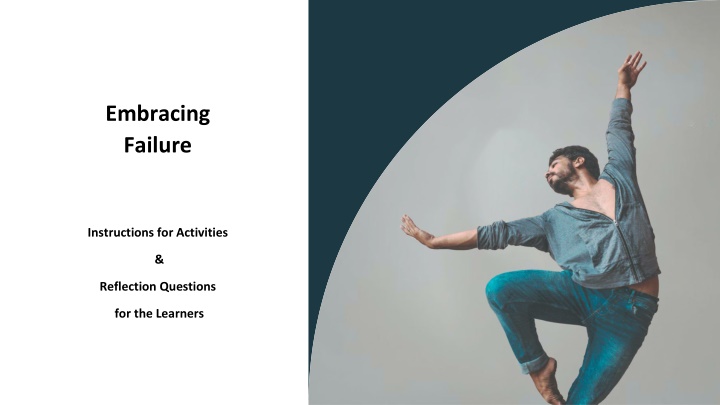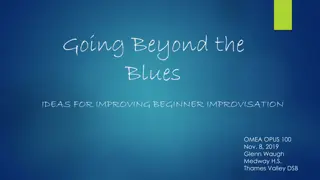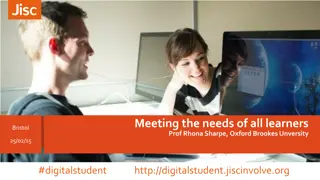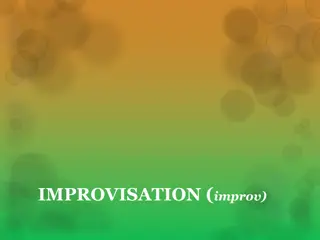Unique Ice Breakers and Improvisation Activities for Learners
Engage your learners with creative ice breaker activities such as relating names to pictures, using adjectives to describe each other, stepping into the client's shoes, and playing a fun game of "Anyone who." Dive into main improvisation activities like leading and following with trust-building exercises. These interactive activities will promote team bonding, creativity, and effective communication skills.
Download Presentation

Please find below an Image/Link to download the presentation.
The content on the website is provided AS IS for your information and personal use only. It may not be sold, licensed, or shared on other websites without obtaining consent from the author.If you encounter any issues during the download, it is possible that the publisher has removed the file from their server.
You are allowed to download the files provided on this website for personal or commercial use, subject to the condition that they are used lawfully. All files are the property of their respective owners.
The content on the website is provided AS IS for your information and personal use only. It may not be sold, licensed, or shared on other websites without obtaining consent from the author.
E N D
Presentation Transcript
Embracing Failure Instructions for Activities & Reflection Questions for the Learners
Ice Breaker Improvisation Activities
Ice Breaker #1: Relate your name to the picture Instruction Each learner will talk about the random picture given by the instructor using their name as the third person. For example, if the name of the learner is Julianna and the picture is a tree, the learner (Julianna) says: Julianna had a tree house when she was 9.
Ice Breaker #2:Three adjectives Instruction Learners make pairs. Person A comes up with three adjectives to describe person B. Person B will pick one adjective from them that person B thinks that adjective describes them and tells person A why. Then they switch roles.
Ice Breaker #3: Be the client Instruction The learners make small groups. The group is tasked with describing a problem as if they are the client. Each person in the group contributes 1 sentence of details about the problem. They must attempt to make the problem make sense.
Ice Breaker #4: Anyone who Instruction Online Learners will be in the main hosting room for this game. All participants will start with their cameras turned off. The facilitator asks for example anyone who likes snow . Those that answer yes turn their cameras on for seconds and then turn the camera off waiting for the next anyone who In-person The game can extend into anyone who , with the person in the middle calling out something that is true for them, if it is true for other participants, they are to find a new seat. If they do not find a seat in time, they become the person in the middle of the circle.
Main Improvisation Activities
Activity #1:Lead and follow, Trust Instruction The learners make a line, close their eyes with a band in a way they don t see at all, and put their hands on the shoulder of the person in front of them except for the leader-the first person in the line whose eyes stay open. The first person in the line with the open eyes starts moving gently and occasionally changes the direction. There is no talking or guiding involved. Everyone in the line will be following the person in front of them. keeping the chain steady and connected while moving, is the essential responsibility for the whole group.
Reflection questions for Learners #1 - How did you feel when you were led with closed eyes? - What was the difference between being a leader and being led? - How would you connect the concepts of risk and trust? - Is there any application for this activity in engineering design thinking process? - Are there any aspects of improvisation in this activity?
Activity #2: Lead and follow through touch alert Instruction The learners make pairs. Each member of the pairs decides if they want to be the leader or the follower, they switch afterward anyway. The leader stands behind the follower and puts their hands on the shoulder's partner. The person in front (the follower) covers their eyes with a band in a way they cannot see at all. Then the pair determine touchy signs for different direction. (e.g., Squeezing the right shoulder for moving forward, left shoulder for backward, right arm for turning right, left arm for turning left; and touching the middle back for stop). Then they switch.
Reflection questions for Learners #2 Reflection questions - How did you feel when you were led with closed eyes? - How comfortable you were to be led by someone behind you? - How would you connect the concepts of risk and trust based on the activity? - Is there any application for this activity in engineering design thinking process? - Are there any aspects of improvisation in this context?
Activity #3: Self-trust, self-lead/follow through active observation Instruction The assistant chooses an area from the place they have access to (home or school ) and determine a start and a finish spot and a path through which the learner is supposed to go from the start to the finish spot. Then the assistant randomly puts obstacles in the chosen path. Afterward, the learner actively observes the path as well as the obstacles in it. Finally, the assistant covers the learner s eyes in the way they are not able to see at all and askes the learner to move through the chosen path.
Reflection questions for Learners #3 I. How would you connect the concept of trust and taking risks in this activity? II. How did you experience being the follower and the leader at the same time? III. Were there any objects/aspects in your place that you had not noticed before, but you explored them after your active observation? IV. Is there any application for this activity in engineering design thinking process? V. Are there any aspects of improvisation in this activity?
Activity #4: Self-trust through Active listening Instruction Online For this activity five assistants use their voices as guidance to direct the active listener/the learner to move around. Each voice addresses one specific direction (e.g., one for sign of moving Forward, another one as Backward, third for turning to the Right, the fourth one for turning toward the Left, and the fifth one as the sign of Stop). They call the active listener s name randomly (Not more than one voice at the same time) and learner moves slowly based on the given direction through voices with closed eyes. In-person Everything is the same, except for the assistants who locate themselves beside each other somewhere in the place while directing the main player.
Reflection questions for Learners #4 - Did you have any new perception of your colleagues voice in this experience? - Have you experienced a new feeling hearing your name as a guideline for your direction? - How would you connect the concepts of risk and trust yourself and others? - As an assistant how would you reflect on being the guide in this activity? - Is there any application for this activity in engineering design thinking process? - Are there any aspects of improvisation in this context?
Activity #5: Improv Design Instruction Learners will be assigned to groups of 3-4. They will be given 3 minutes to decide amongst themselves the order of the presenters. Once the groups are ready, the groups will go up and improvise a presentation for a device designed to improve the user s life in some way. They must connect the ideas of each presenter into one device design.
Reflection questions for Learners #5 -How did it feel to present first? -How did it feel to have to think on the spot? -How did it feel to have to connect previous ideas to your own? -How did it feel to change the slides (if applicable) -Has your perspective around the concept of improvisation changed? Why or why not?
Activity #6: Creative Design Instruction The learner will be given the design problem to develop an assistive device for putting on clothing, such as a button up shirt. The learner will then be given 2 minutes to brainstorm a list of possible solutions. After the 2 minutes is up, the participant needs to select 5 everyday household objects. Then, in 10 minutes, the learner will develop an assistive device using those 5 selected objects. At least 2 of the objects must be used. Afterwards, the learner should brainstorm a new list of solution ideas in 2 more minutes.
Reflection questions for Learners #6 - How did the solution ideas change from before designing the device to afterwards? - Did you think of something unexpected? - Which object was the most difficult to include in the design? - If you were to do this exercise again, what objects would you choose? - Was it difficult to create a solution when you also had to decide what type of clothes it would help with?
Activity #7: Drawing Design Instruction Learners will form a group and create a drawing collaboratively. One person will be the leader, and the rest will be the followers. Step 1: The leader will come up with an object or a scene in mind. Based on that, the leader will provide a starting point for the drawing. A good starting point should give the followers a rough idea of what the scene/object might be and the least possible hints. Step 2: Based on the given starting point, the followers will be asked to complete the drawing collaboratively. Step 3: At certain time point, the leader will ask everyone to stop drawing. Step 4: Each follower will type a brief description of the final drawing in the chat. Step 5: Based on the given starting point, the leader will complete the drawing. Then the leader will reveal the scene/object in mind.
Reflection questions for Learners #7 - As a leader, what did you observe during the drawing design? Did the drawing go as you predicted? - As a follower, how did you feel when collaborating with other followers? - After doing this activity, what are your new perspectives on improvisation? - How would you relate to improvisation in the context of the engineering design process?























